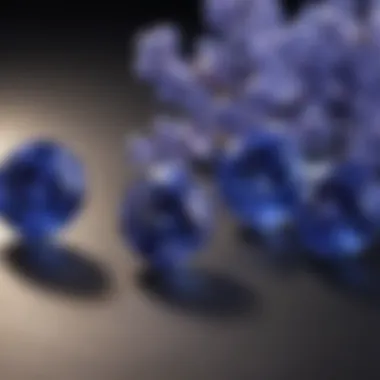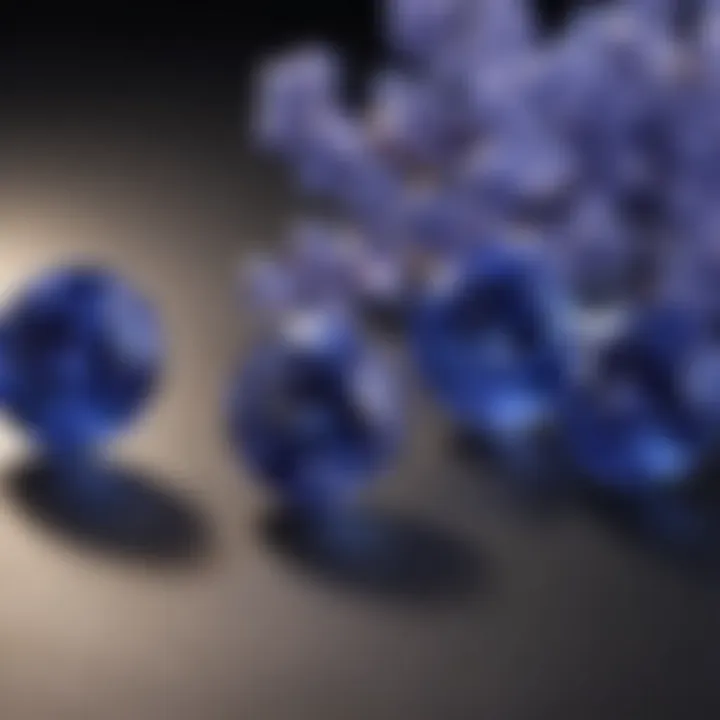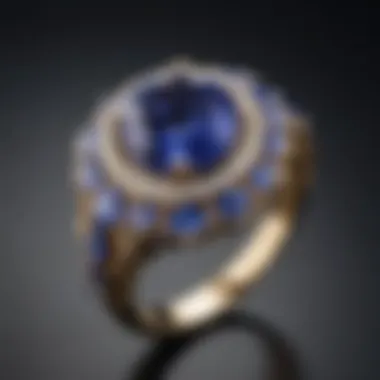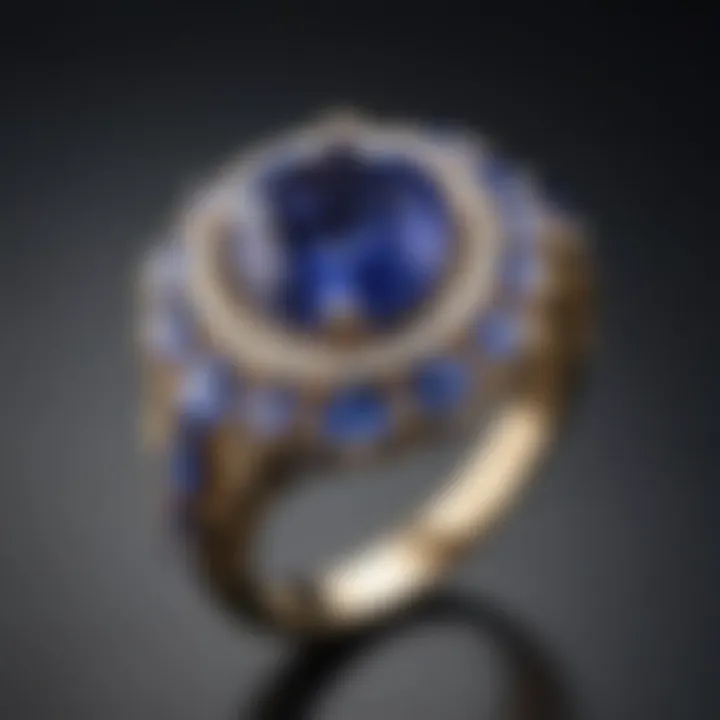Exploring the Depths of One Carat Tanzanite


Intro
Tanzanite, known for its deep blue and violet hues, has captivated collectors and gem enthusiasts. Specifically, a one-carat tanzanite gem can showcase the prowess of nature's artistry. Understanding this gemstone requires a detailed look at its properties, history, and significance. This overview aims to provide a thorough understanding of one-carat tanzanite, exploring its unique characteristics and market relevance.
Gemstone Overview
Definition of Gemstones
Gemstones are precious or semi-precious minerals that have been cut and polished for use in jewelry and decoration. Each gemstone is valued for its rarity, beauty, and durability. Tanzanite falls under the category of gemstones due to its exquisite colors and unique properties.
Classification of Gemstones
Gemstones can be classified into two main categories: precious and semi-precious. Precious gemstones include diamonds, rubies, sapphires, and emeralds. Semi-precious gemstones encompass a wider variety, including tanzanite. The classification is often based on aspects like rarity, economic value, and quality.
Tanzanite is particularly notable for its unique trichroism, displaying three distinct colors: blue, violet, and burgundy. This characteristic sets it apart from many other gemstones, making it highly sought after.
Historical Significance
Origins of Gemstone Use
Gemstones have been used throughout history for ornamental and symbolic purposes. They held significant meaning in many cultures, often believed to provide protection or promote healing. The use of gemstones can be traced back thousands of years, with some of the oldest artifacts dating back to ancient civilizations.
Tanzanite, however, is a relatively recent discovery. It was first found in the 1960s in Tanzania, near Mount Kilimanjaro. Since then, it has garnered attention for its vibrant color and rarity.
Cultural Insights: Gemstones in Ancient Civilizations
Ancient civilizations had a profound appreciation for gemstones. The Egyptians, for instance, used lapis lazuli and turquoise for jewelry and ornaments, associating their colors with various deities and beliefs. Meanwhile, gemstones like garnet and amethyst were popular in ancient Rome and Greece, often worn by the elite.
The fascination with gemstones often transcended mere aesthetic value. They were seen as carriers of energy and often linked to astrological beliefs. Although tanzanite is not ancient, its rapid rise to prominence in modern jewelry design parallels the historical significance that other gemstones once held.
For more information about gemstones and their roles in history, consider exploring Wikipedia.
"Gemstones, in many cultures, are more than decorative. They embody social status, spiritual beliefs, and artistry."
This overview serves to set the stage for a deeper exploration of one-carat tanzanite, delving into its geological formation, market value, investment potential, and care considerations.
Understanding Tanzanite
Tanzanite is a gemstone that has captivated many with its unique color and rarity. Understanding this gemstone is essential for collectors, jewelers, and enthusiasts alike. This section delves into the geological characteristics and physical properties that define tanzanite, particularly focusing on its formation and quality indicators.
Geological Formation
Formation Process
Tanzanite's formation process is a complex one, taking place over millions of years within specific geological conditions. The mineral zoisite undergoes a unique transformation under heat and pressure, resulting in the stunning deep blue to violet hues that characterize tanzanite. Its metamorphosis is a lengthy and beneficial process, contributing to tanzanite’s exceptional qualities. One of the key characteristics of this formation is that it requires specific elements, such as vanadium, to achieve its distinct coloration.
The advantage of this formation process is that it produces gems with a remarkable depth of color. However, tanzanite is also relatively soft compared to other gemstones, making it susceptible to scratching.
Location and Distribution
Tanzanite is predominantly found in a small area near Mount Kilimanjaro in Tanzania. This limited location adds to its allure and rarity. The key characteristic of this distribution is its exclusivity; tanzanite is not found in abundance like some other stones. The benefits of this unique location are significant, as it often translates to a higher value in the market.
Nonetheless, the localized nature of tanzanite mining presents certain disadvantages. The region is vulnerable to environmental changes, which can impact both quality and availability.
Physical Properties of Tanzanite
Color and Clarity
The color and clarity of tanzanite are among its most appealing traits. The deep blue color, enhanced by trace amounts of chromium, is particularly sought after. Clarity plays a critical role in determining value; higher clarity gems fetch significantly higher prices. A key point to note is that the color can change under different lighting conditions, known as pleochroism, which adds a unique dimension to the stone.


This characteristic is beneficial for enhancing its aesthetic appeal. However, potential buyers should be aware that not all sources provide uniform quality.
Cut and Carat Weight
The cut and carat weight are also crucial factors in assessing tanzanite's overall value. A well-cut stone enhances its brilliance and color dispersion, making it more desirable. The carat weight provides an indication of the stone's size, which greatly influences its market appeal. Generally, larger stones are rarer, therefore more valuable.
While large carat weights may be visually overwhelming, often buyers prefer well-cut smaller stones that maximize color and clarity. Thus, striking a balance in size and cut is vital for both aesthetics and value.
The Significance of One Carat
Evaluating the significance of a one carat tanzanite goes beyond mere weight. It encompasses both its market presence and its intrinsic value in various contexts. Tanzanite is not just another gemstone; it carries a unique set of characteristics that contribute to its desirability and marketability. As a result, understanding its true value is essential for gem enthusiasts, collectors, and investors alike.
Market Value Insights
Price Fluctuations
Price fluctuations in the tanzanite market are influenced by several factors, including supply sensitivity and consumer demand. Unlike more common gemstones, tanzanite is relatively rare. Its supply is limited to a small area in Tanzania, which creates competiton among buyers. The prices can vary significantly depending on clarity, cut, and color saturation. For instance, high-quality tanzanite often commands a premium due to its exquisite hues and rarer characteristics.
One defining characteristic of price fluctuations is that they can be both advantageous and disadvantageous. On one hand, increased value may indicate an appreciating asset; on the other hand, volatility can deter potential buyers. Understanding these market dynamics is key for anyone keen on purchasing a tanzanite.
Investment Potential
The investment potential of a one carat tanzanite is another critical factor to consider. Given its rarity and beauty, tanzanite has established itself as not just a decorative piece, but as a viable long-term investment. Many investors see it as a hedge against economic uncertainties. Properly sourced and authenticated tanzanite, particularly in larger carat sizes, can appreciate significantly over time.
One important aspect of investment potential is the growing interest in ethically sourced gemstones, which has added an extra layer of desirability to tanzanite. Investors increasingly seek transparency in origins, making ethically mined tanzanite a more attractive option. This shift towards sustainability can positively affect its market value and future demand.
Comparative Analysis with Other Gemstones
Comparisons with Sapphire
Tanzanite often draws comparisons with sapphire due to their similar color ranges, particularly shades of blue. However, there are important distinctions to note. While sapphires have long been regarded as symbols of status and luxury, tanzanite’s relative novelty can sometimes appeal to buyers looking for something distinct. The unique trichroic properties of tanzanite—displaying different colors when viewed from different angles—offer a dynamic visual experience that sapphires do not provide.
The benefit of comparing tanzanite with sapphire lies in understanding its niche. Buyers of tanzanite may appreciate its uniqueness which is something sapphire lovers may not experience as frequently. However, tanzanite's comparative lack of familiarity might affect its visibility in the luxury market.
Emerald and Ruby Comparison
When contrasting tanzanite with emerald and ruby, its significant characteristics come into play. Both emeralds and rubies carry historical prestige and market standing, making them fan favorites in luxury jewelry. Tanzanite offers a fresher, modern alternative to these established gemstones. Many new buyers are drawn to tanzanite's narrative and uniqueness, positioning it as a compelling option against these classic choices.
This comparison emphasizes that while tanzanite may not yet hold the same market status as emeralds and rubies, its beauty and rarity make it a worthy contender. Again, understanding these differences enriches a buyer's perspective and supports informed decision-making.
"The allure of tanzanite lies not only in its stunning hues but also in the rich stories surrounding its market presence and cultural significance."
Through careful analysis of its market value and comparative appeal, it becomes clear that one carat tanzanite possesses unique benefits and considerations crucial to understanding its role within the gemstone landscape.
Cultural and Historical Context
Understanding the cultural and historical context of one-carat tanzanite is essential for appreciating its significance and allure. This gemstone is not merely a product of geological processes but is also steeped in rich traditions and vivid histories that enhance its value. Cultural references and historical milestones inform its desirability and provide insights into its journey from discovery to modern-day relevance.
Historical Discovery
Discovery in Tanzania
The discovery of tanzanite took place in 1967, in the Merelani Hills of Tanzania. This region, known for its unique geological formations, is the sole source of tanzanite in the world. The mining of this gemstone has profoundly affected the local economy. The key characteristic of this discovery is its immediacy; it has swiftly transformed from an unknown mineral to a highly coveted gemstone. This is beneficial for both collectors and the locals involved in mining.
Tanzanite stands out due to its remarkable blue and violet hues, which were first documented shortly after its discovery. These colors have made it a desirable choice among gem enthusiasts. However, the accessibility of tanzanite is limited strictly to this locale, creating a sense of exclusivity and enhancing its appeal in international markets.
Cultural Impact
Tanzanite’s cultural impact stretches far beyond its mineral properties. It has been embraced by various cultures, becoming symbolic of different meanings and sentiments. The gemstone is often associated with good fortune and spirituality. Its deep blue hue resonates with notions of calm and peace, making it a desirable choice for meaningful gifts. This characteristic plays a significant role in its popularity among jewelry designers.
Culturally, tanzanite has been featured in numerous artistic expressions and traditional ceremonies, solidifying its importance. However, it has a dual nature—while highly revered, its rapid commercialization might dilute some of these cultural associations. Collectors and jewelers must therefore navigate this landscape carefully, respecting its heritage while engaging with the market.


Modern Usage
Celebrity Endorsements
In contemporary society, tanzanite has been prominently featured in the collections of celebrities. Notable figures have adopted this gemstone, not only showcasing its beauty but also promoting it to wider audiences. This endorsement creates a buzz around the gemstone, increasing its visibility in the luxury market. The key characteristic of celebrity endorsements is the ability to enhance the stone's brand image, creating a desirable perception that influences purchasing decisions. For many, owning a piece of jewelry adorned with tanzanite is synonymous with status and sophistication.
However, this exposure comes with complexities. While it boosts market demand, it risks overshadowing the gem's unique heritage. Jewelers need to consider these factors when marketing tanzanite.
Weddings and Celebrations
Tanzanite has found a meaningful place in weddings and celebrations. Couples are increasingly selecting this gemstone for engagement rings and other jewelry pieces, often to encapsulate the uniqueness of their love story. It adds a distinct color and character to traditional wedding jewelry, setting it apart from more conventional options like diamonds. The vibrant hues resonate with emotions and create lasting memories, enhancing the significance of celebrations.
One challenge in promoting its use in weddings is the potential competition with traditional stones such as diamonds. Despite this, the distinctiveness of tanzanite often persuades couples to choose it for its unique qualities, making it a beneficial choice for those looking to commemorate special occasions.
Ultimately, the cultural and historical context surrounding one-carat tanzanite illustrates its dual nature as both a precious gem and a cultural artifact. Understanding its journey from discovery in Tanzania to its modern uses provides crucial insights for enthusiasts, collectors, and jewelers.
Choosing the Right One Carat Tanzanite
Choosing the right one carat tanzanite is an essential aspect for anyone interested in this unique gemstone. This section will cover key elements that assist collectors and buyers in making informed decisions. Selecting the right tanzanite involves understanding quality indicators and knowing where to purchase these stones. The goal is to ensure that enthusiasts receive the best value for their investment while enjoying the aesthetic and emotional benefits of owning this gemstone.
Quality Indicators
Assessing Cut and Clarity
Assessing cut and clarity significantly influences the visual appeal and overall value of tanzanite. The cut of the gemstone refers to how well it has been shaped and faceted, affecting its brilliance and sparkle. A well-cut tanzanite will reflect light more efficiently and display a richer color. Clarity, on the other hand, gauges the presence of internal or external flaws. High clarity stones are more sought after and typically command higher prices.
Key characteristics of assessing cut and clarity include:
- Expert craftsmanship is vital for achieving the ideal proportions.
- Darker shades and vivid hues indicate high-quality tanzanite but require proper cutting to accentuate their color.
The unique feature of assessing cut and clarity lies in its ability to enhance the stone's overall beauty, drawing out its deep blues and purples. However, buyers should be cautious; purchasing a gemstone based solely on appearance without considering these factors might lead to unsatisfactory results.
Identifying Authenticity
Identifying authenticity is another crucial aspect in the selection of tanzanite. Given that imitation stones and synthetics can easily be mistaken for natural tanzanite, understanding the authentic characteristics of genuine stones is important. A legitimate tanzanite will display specific attributes, such as pleochroism, where the gem exhibits different colors when viewed from different angles.
Highlights of identifying authenticity include:
- Certification from reputable gemological laboratories provides assurance.
- Inclusions can often determine the natural origin of the stone.
The unique feature of identifying authenticity is that it safeguards the buyer from fraud and enhances the investment value of the gemstone. Collectors and enthusiasts should verify authenticity to ensure they acquire genuine and quality stones.
Retail Environment
Choosing Reputable Jewelers
Choosing reputable jewelers is critical in the process of purchasing tanzanite. Selecting a trustworthy jeweler can make a significant difference in the quality and authenticity of the gemstone acquired. A jeweler with a solid reputation often reflects years of experience and a commitment to customer education.
Key characteristics include:
- Transparent pricing and detailed descriptions of the gemstones.
- Customer reviews that showcase satisfaction and trustworthiness.
A unique feature of choosing reputable jewelers is that they can provide educational resources and personalized guidance. This can lead to better decisions and investments, preventing misunderstandings or dissatisfaction post-purchase.
Online vs In-store Purchases
The debate between online vs in-store purchases of tanzanite also merits consideration. Each method has distinct advantages. Online purchasing provides convenience and often a wider selection, while in-store options allow buyers to feel the gemstones and view them in natural light.
Highlights of each include:


- Online purchases offer ease of comparison between prices and styles, enhancing buyer choice.
- In-store purchases provide the benefit of physical assessment and immediate delivery.
The unique feature of this comparison lies in the importance of researching both environments. Buyers should explore both avenues to determine what aligns best with their expectations and needs. Understanding the pros and cons can lead to a satisfying purchase experience.
"Investing in a one-carat tanzanite involves careful thought. Quality, authenticity, and a reliable purchasing environment are key factors for successful ownership."
Considering these detailed points will prepare gem enthusiasts and buyers for selecting the right one carat tanzanite gem that aligns with their tastes and investments.
Care and Maintenance
The care and maintenance of one-carat tanzanite are essential for preserving its beauty and longevity. Proper handling not only enhances the visual appeal of the gemstone but also secures its investment value. Tanzanite, known for its striking color and unique properties, requires special attention, as neglect may lead to irreversible damage or degradation over time. Therefore, understanding the right cleaning and storage techniques is vital for both collectors and casual buyers.
Cleaning Techniques
Safe Cleaning Methods
Cleaning methods used for tanzanite must prioritize safety to avoid damaging the stone. One key characteristic of safe cleaning methods is their gentle approach. For instance, using a soft cloth or a brush with soft bristles can effectively remove dirt without scratching the surface. Another popular technique is to use lukewarm soapy water, as it provides a mild solution that helps maintain the stone's luster. Importantly, harsher chemicals or sonic cleaners can harm tanzanite, thus should be strictly avoided. Ultimately, these safe cleaning methods support the overall goal of maintaining the gemstone's condition, allowing it to be enjoyed for years to come.
Recommended Products
In maintaining one-carat tanzanite, selecting the right cleaning products contributes significantly to the goal of effective care. Recommended products often include pH-neutral cleaners specifically formulated for delicate gemstones. The key characteristic of these products lies in their gentle yet effective formulation. They are beneficial choices for those who prioritize the safety of their investment. A unique feature of these recommended products is that they often come with instructions tailored for tanzanite care, which can further enhance their effectiveness. However, caution should be exercised; not all cleaning products are suitable, and incorrect usage might lead to discoloration or damage.
Storage Recommendations
Environment Considerations
When it comes to storing one-carat tanzanite, environmental considerations play a crucial role. Storing the gemstone in an environment with stable temperature and humidity can prevent any significant changes or damage. One key characteristic of these environmental factors is their ability to maintain the stone's structural integrity. This type of careful storage assures collectors that their investment remains safe from external factors like excessive moisture or extreme heat that could lead to cracks or fading. The unique benefit of controlling the environment is that it helps maintain the exceptional visual quality and enhances the overall longevity of the stone.
Security Measures
Security measures for storing tanzanite must not be overlooked. The main aspect to focus on is how to protect the gemstone from theft or loss. One beneficial choice is to use a safe or a well-secured jewelry box. A good practice involves aligning these security measures with valuable storage points, ensuring easy accessibility yet higher protection levels. The unique feature of effective security measures includes advanced locking mechanisms that deter unauthorized access. However, it is important for owners to remember that while high security may provide peace of mind, it should not compromise accessibility, especially if the tanzanite is often worn or displayed.
Future Trends in Tanzanite Market
The future of the tanzanite market holds significant implications for collectors and enthusiasts. As interest in this rare gemstone grows, understanding upcoming trends becomes essential. These trends may encompass sustainability practices, ethical sourcing, and changing market demands influenced by global cultural shifts. Awareness of these elements allows buyers to make informed decisions and supports the broader conversations around environmental responsibility in gem sourcing.
Sustainability and Ethical Sourcing
Environmental Impact
Environmental impact focuses on how gemstone mining affects ecosystems. Traditional mining methods have led to deforestation, soil degradation, and water pollution. As a response, the tanzanite industry sees an increasing shift toward eco-friendly methods.
Sustainable practices can reduce negative outcomes and promote biodiversity. For tanzanite, using less disruptive extraction techniques is crucial. This not only protects habitats but also helps local communities by providing them healthier living conditions. Sustainable choices are becoming a selling point for jewellers and buyers, aligning with a growing preference for responsible consumption.
Ethical Mining Practices
Ethical mining practices relate to how gemstones are sourced. They prioritize fair labor, safe working conditions, and respect for local communities. In the context of tanzanite, this is increasingly important. Ethical sourcing can enhance a gemstone's value, appealing to conscious consumers.
Responsible mining not only benefits workers but also ensures the community shares in the mining wealth. Therefore, practices like certification and traceability are gaining attention. For buyers, understanding these practices can lead to more meaningful purchases that contribute positively to society and the environment.
Market Projections
Demand Analysis
Demand analysis investigates market conditions impacting tanzanite sales. An increase in awareness about tanzanite's rarity could escalate its demand. Over time, as more people discover this gemstone, they may choose it over alternatives like sapphires or rubies.
Record sales can reflect a well-informed consumer base that values uniqueness and beauty. However, global economic conditions also play a role. For instance, during financial crises, luxury goods often see a drop in demand. Thus, a thorough understanding of market dynamics is crucial in anticipating future trends.
Collecting Trends
Collecting trends analyze emerging patterns in gemstone acquisition. There is a noticeable shift among collectors toward acquiring rarer and unique stones, including tanzanite. The growing interest fuels competition and, subsequently, the prices for top-quality stones may rise.
Social media plays a role in how collectors interact and share their experiences. Platforms like Instagram and Reddit have become spaces where enthusiasts showcase their collections and engage with each other. Keeping an eye on these trends helps both collectors and jewelers adjust their strategies to meet the evolving interests of the market.
"Understanding future trends can provide crucial insights for anyone interested in tanzanite, from collectors to jewelers."
Market trends are moving towards responsible sourcing and rare gemstones. Staying informed is key to making educated decisions in this captivating world.



